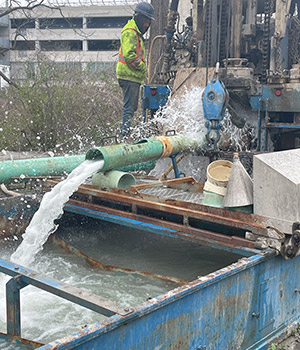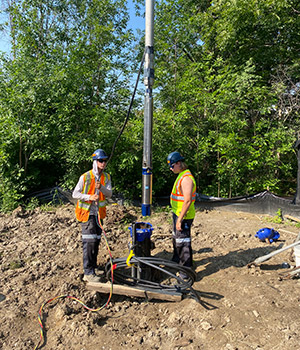
Summary
When designing its new head office building, the Toronto and Region Conservation Authority (TRCA) intended to use a closed-loop geothermal system for heating and cooling. But subsequent testing led them to pivot to an open-loop system due to its increased environmental benefits and the opportunity to demonstrate the value of this innovative technology.
Background

The Toronto and Region Conservation Authority (TRCA) has a mandate to care for the natural environment and protect communities and ecosystems from the impact of flooding and other extreme weather events. Its jurisdiction covers 3,467 km2.
TRCA is building a new head office and has been incorporating sustainability into all aspects of the process, with the aim of achieving a zero-carbon design. The intention is for the building to be both a functional space and a demonstration of green and net-zero construction techniques that can inform and inspire others.
Original plans included a closed-loop geothermal system as an energy-efficient way to provide heating and cooling. However, during test drilling, engineers found they could potentially switch to an open-loop geothermal system or an aquifer thermal energy storage system, both of which can be more energy efficient and cost effective than closed-loop systems but are uncommon in Canada. All of these systems use underground pipes to draw heat from the earth in the winter and expel heat from the building in the summer, but in different ways and with different infrastructure needs.
The challenge

While TRCA was prepared to move forward with a closed-loop system, they knew that the discovery of the aquifer presented an opportunity to test the feasibility of the alternatives. The questions were: would an open-loop or aquifer thermal system work for their building? And if so, would it be worth it for them to implement it?
Approach
With financial support from FCM, TRCA decided to do a feasibility study to discover which of the three systems would be the best choice for their site. This included exploratory drilling to answer the following questions:
- Is there sufficient groundwater under the site?
- Does the groundwater move slowly enough for interseasonal storage of heating and cooling potential?
- Is the groundwater chemistry likely to cause scaling or corrosion, which could hinder system performance?
The study also included analysis of the costs, construction-related environmental impact and future energy use of each option.
Results

The study showed that any of the options would work on the TRCA building site. TRCA decided to abandon its plans for closed-loop geothermal in favour of an open-loop system for reasons including:
- Lowest cost, with a savings of approximately 25 percent.
- Lower emissions from installation and 25-year operation, at 77.8 tCO2e.
- Less disruption of the surrounding natural environment, in part due to requiring only four open loop boreholes rather than 44 closed loop boreholes.
Benefits
Given TRCA’s mandate to showcase green building technologies, installing a highly functional yet less common open-loop system is an opportunity to share knowledge and advance uptake of this kind of technology.
Lessons learned
TRCA realized they should have done a hydrogeology study initially upon selection of geothermal heating and cooling, rather than embarking on test drilling with only a closed-loop system in mind. Many costs could have been avoided by considering all potential options when test-drilling.
On a regional level, there could be advantages to understanding the underlying geology of specific regions ahead of time to identify high-potential sites for open-loop or aquifer thermal systems.
Next steps
TRCA has moved forward on design and installation of an open-loop system for its head office site. In order to maximize the longevity of this system, they are planning a monitoring and maintenance program that will help them minimize the impact of common issues such as scaling and clogging.
Want to explore all GMF-funded projects? Check out the Projects Database for a complete overview of funded projects and get inspired by municipalities of all sizes, across Canada.
Available funding
We support projects at various stages of development through grants and loans. Funding amounts are based on total eligible costs. Further details on eligible costs are provided on individual funding pages.
Business case: Community Energy Systems
Funding to assess viable community energy projects and their business models
Read moreStudy: Community Energy Systems
Funding to outline the design of a proposed community energy system
Read moreCapital project: Community Energy Systems
Funding to construct, commission and rapidly deploy a community energy system
Read more
